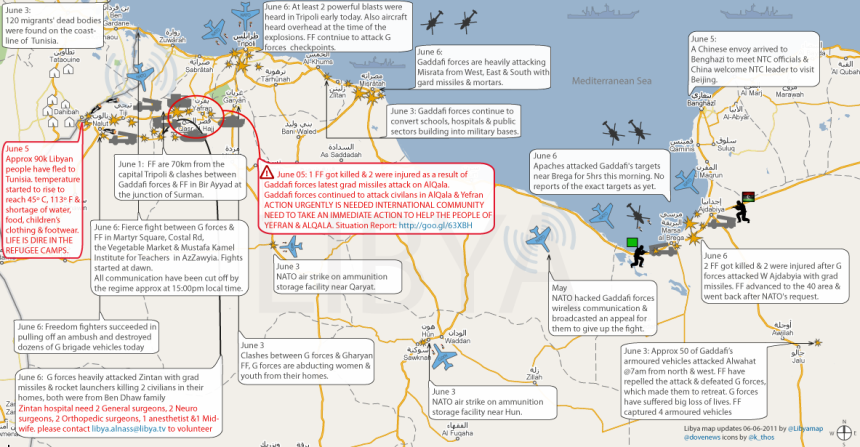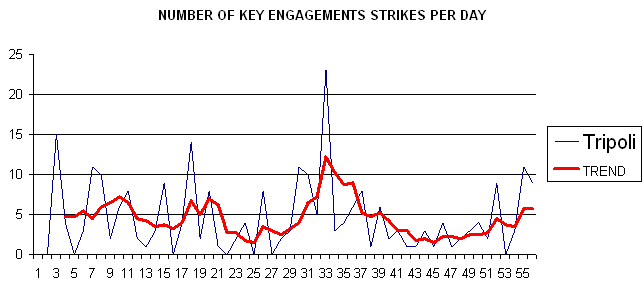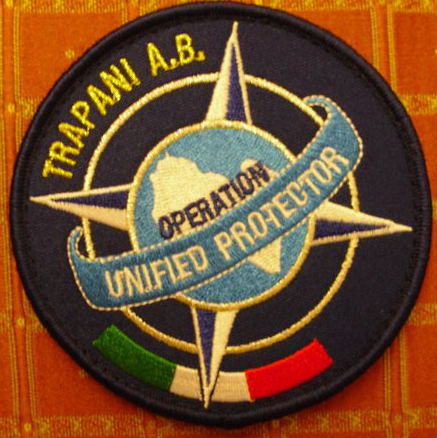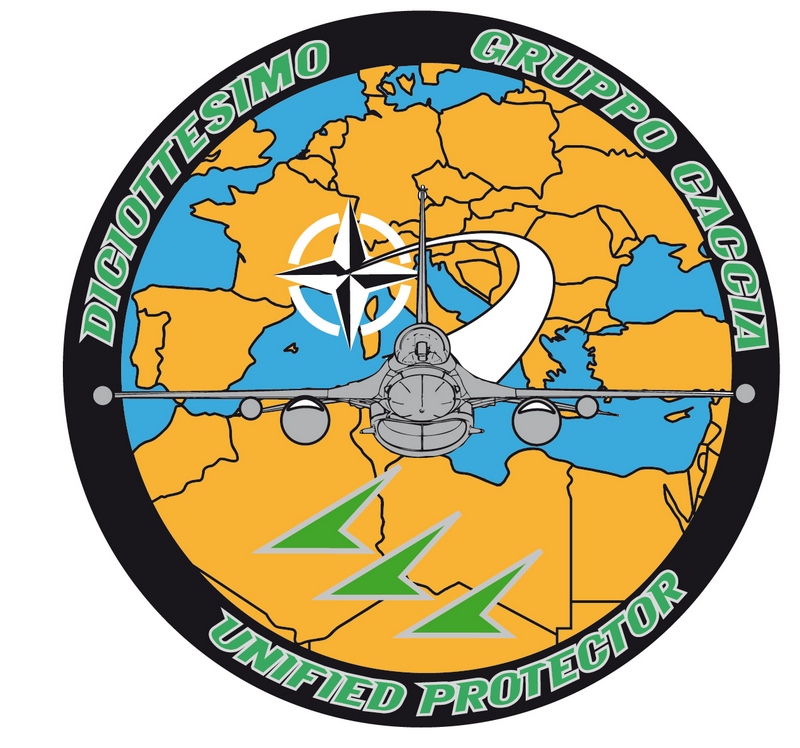Previous debriefings: Archive
As reported in the previous Debriefs, although not being as intense as one might expect, NATO air campaign may be slowly paying off. Thanks also to the coalition’s air strikes (and to some modern equipment along with a better organization) the rebels have been able to establish a stable control over the east of the country and the mountain range southwest of Tripoli, as well as breaking the siege on Misratah, from where they are trying to advance west, towards Libya’s capital city.
Reuters reported that Gaddafi’s forces are still quite active in Zintan, another mountain town about 40 km (25 miles) west of Yafran, that was attacked with Grad rockets, and in the rebel-held town of Ajdabiyah in the east where pro-Gaddafi forces fired rockets.
Even if loyalists seem to resist, three months into the revolt against Gaddafi’s 41-year power, the regime could be close to collapse. His forces, suffering significant losses and reduced to just a fifth of their strength, can’t be supplied and the number of members of the armed forces who have defected or deserted increases each day. For instance, eight senior officers (including four generals) of Gaddafi’s military defected on May 30 (BTW: this is considered an Italian intelligence success). Shortage of food and fuel have had a significant impact on army and population’s morale.
Therefore, NATO has focused on Libyan leader’s stronghold in central Tripoli where allied aircraft have bombed the area around Gaddafi’s Bab al-Aziziya compound.
Map by @LibyaMap
According to NATO Secretary General Anders Fogh Rasmussen air strike have destroyed or damaged some 1.800 legitimate targets in Libya including around 100 Command and Control sites, 700 ammunition storage facilities and almost 500 tanks, APCs and rocket launchers. What is weird and gives an idea of the lack of strategy NATO has shown so far is that coalition planes, 80 days since the beginning of Odyssey Dawn (then Unified Protector) still has some fixed targets (like C2 sites, national intelligence centre, State TV antennas, and so on) to attack: as already said many times, these targets should be hit in the very early phases of any offensive air campaign.
Since NATO took over command of air strikes on March 31, its aircraft have conducted a total of 10.020 sorties, including 3,794 strike sorties. NATO mission was extended for another 90 days.
Here’s the trend of air strikes and key engagements (as reported by NATO), based on the graphs made by @88simon88
Other interesting things, information and thoughts:
1) I’ve often explained that “liaison officers” (or Special Forces) from some coalition partners were already operating on the ground in Libya. The following AJE video shows some of them supporting rebel forces. One of them can be seen at 00:04s the other one from 02.12s.
According to the Guardian, those with “boots on the ground” are SAS veterans and private security firm employees, there with the blessing of coalition partners which have supplied them with communication equipment, helping NATO identify Gaddafi targets in Misratah and pass them to attack helicopters. The targets are then verified by spy planes and US drones because “One piece of human intelligence is not enough” a source said to the British newspaper.
[youtube=http://www.youtube.com/watch?v=7On6uKaabKw]
2) In the night between Jun. 3 and 4, the attack helos were ordered into action: the French heli group, comprosing (according to sources) 12 Gazelles, 2 Tigers and 4 Pumas operating from Tonnerre, 15 vehicles and 5 command and control targets located in the Brega area; two British Apaches launched from HMS Ocean (and flown by crews with a certain experience in Afghanistan) hit a radar site and an armed checkpoint. The attack choppers operated in the darkness because of the residual risk to come under fire from small arms, RPGs and MANPADS. Noteworthy, the Apaches returned safely to the Royal Navy warship after briefly coming under fire from AK47s.
The Express.co.uk website interviewed one of the AH-64 pilots involved in the first mission in anarticle that can be read here. Here’s an excerpt (I’ve underlined few interesting things):
The mission commander told how the two attack helicopters used cover of darkness early on Saturday to fly from HMS Ocean and destroy a radar installation, which had already survived a raid by Nato fast jets, and then eliminate an anti-aircraft gun.
White flashes from the explosions 30 miles away were visible from the flight deck of the helicopter carrier HMS Ocean – the Royal Navy’s largest warship.
The pilot, who cannot be named for security reasons, destroyed the 3ft sq radar on top of a 100ft mast with just one laser-guided Hellfire missile.
The Apaches then raced off to observe a checkpoint manned by Gaddafi’s forces, where they came under small-arms fire.
When an anti-aircraft gun on the back of a big flatbed truck turned on the Apaches, one of them destroyed it with a couple of well-aimed bursts from his 30mm cannon, triggering a chain reaction of explosions so fierce the Apaches had to pull away.
[…]
Earlier that evening, HMS Ocean and the Royal Navy Task Group, maintaining radio silence and with lights dimmed, had closed to within sight of the Libyan shore, whose shimmering lights would help guide the helicopters to their targets.
[…]
The Apaches lifted off on a night so dark many other aircraft would not have been able to operate.
Invisible against the night sky, they raced for 20 minutes across the Mediterranean towards Brega – now in Gaddafi’s hands.
Just a couple of hours after the raid, the pilot said: “Tonight was absolutely black but we used infra-red.
“The first target was a radar installation.
“It was a coastal defence radar which was monitoring shipping and aircraft. We are here to protect civilians and we need to stop things that are stopping us. It has been bombed before but it is difficult to drop a bomb on a target like this.
“But I can fly the helicopter from sea level to very high, I can get absolutely the right angle and I fired a laser-guided Hellfire missile – the time from pulling the trigger to impact was about 12 seconds – and got it first time.
“I also fired two Hellfire into the base of the radar site, which buckled the tower, and then two more into the buildings either side, while the other Apache fired another into the base.”
Ten minutes later they closed in on the checkpoint, before returning safely to HMS Ocean.
What’s interesting is that NATO aircraft were unable to destroy a simple, almost undefended, fixed target and helicopters had to be sent to destroy it. The ship had to get closer to the coast in order to reduce the transit time to the target area and to improve the helicopters endurance (I’ve already said that, unless they are based on the ground, attack choppers will be able to operate only in coastal areas).
Isn’t that unusual? Modern warplanes can fly at night and can (quite easily) destroy a fixed target located on the coast. Why using helicopters in a sort of SEAD strike? Only to claim an helicopters attack?
The following video shows French helos being prepared for a mission: the more modern Tiger are equipped with a 30mm gun and 68 mm rockets while the obsolete Gazelles carry 4 HOT missiles. Since those deployed are in the HAP version and can only carry guns or Mistral air-to-air missiles, the role of the French Tigers should be limited to the reconnaissance, fire support or escort, not including anti-tank duties.
[youtube=http://www.youtube.com/watch?v=plFUFwbiUrQ]
3) The RAF has deployed the Enhanced Paveway III LGBs with BLU-109 warheads to Gioia del Colle airbase. The bunker-buster bomb is carried by the Tornado GR4s. However this kind of bomb is used also by the Italian Air Force, that has finally disclosed some more details about the armament used in Unified Protector.
According to the Aeronautica Militare (ItAF) official website, the type of weapons used by ItAF Tornados are:
- GBU-16 PAVEWAY II – EGBU-16: the Italian Tornado IDSs, as shown in the released images, carry the CLDP pod and one GBU-16 with Mk-83 warhead (1.000 lbs). The Enhanced version uses a dual mode GPS/Laser (DMLGB) guidance.
- GBU-24 – PAVEWAY III- EGBU-24: it’s a 2.000 lbs bomb using either Mk-84 or BLU-109 warheads. The Enhanced version uses a dual mode GPS/Laser (DMLGB) guidance.
- GBU-32 JOINT DIRECT ATTACK MUNITION (JDAM): Tornado (and AMX) can carry the GBU-32 (1.000 lbs) JDAM. As images shows, the ItAF Tornados fly with 3 GBU-32s.
- Storm Shadow: stand off missile. It is carried in pairs by Tornado IDSs.
Here you can see some videos released by the ItAF showing Tornados deployed to Trapani carrying the above PGMs: GBU-16 (1), GBU-16 (2), GBU-32, Storm Shadow (and refuel from KC-767A).
According to the Sole 24 ore newspaper, the Italian contingent dropped +200 PGMs & missiles in Libya during the first month of bombing campaign. That is a significant amount of PGMs if compared to the British that have been performing air strikes since Day 1 of Odyssey Dawn, have passed 500 sorties, and released “only” 300+ precision-guided weapons. Since they have joined the air strikes in Libya on Apr. 28, summing up information released by the It MoD, Italians have flown 247 missions (something around 500 sorties), some of which are air defense ones with F-16s and Typhoons. Italian Navy totalled in 80 days 820 flying hours with the AV-8B+ Harrier and 536 flying hours with its helos.
5) The Italian AF Chief of Staff, Lt. Gen. Giuseppe Bernardis, gave Defense News’ Tom Kington an extremely interesting interview covering also the current involvement of the Aeronautica Militare in Unified Protector. Here’s an excerpt (I’ve underlined some interesting things) but I suggest you reading it all since it provides some details about other air force programs:
[…] We are satisfied we can cover the roles we have been given, from transport, support and air defense to attack roles. We are covering almost the whole spectrum of missions, and the results are very good. Like almost everyone else, we lack munitions for moving targets. As such, we have a requirement for next-generation aircraft – meaning the Joint Strike Fighter [JSF] with suitable sensors – that will have the capability to use the Small Diameter Bomb Increment II or an equivalent to strike a moving target with precision.
[About Tornado IDS being used in Unified Protector] We are using our Ret. 6 upgrade aircraft, which have limited night-vision capability. The Tornado ECR [electronic combat and reconnaissance] aircraft have Link 16 ahead of the installation of Link 16 on all Tornados in the future. The IDS [interdictor/strike] aircraft are also flying reconnaissance missions with the Reccelite pod.The Italian AMX fighter bomber is, meanwhile, being used extensively in Afghanistan. […]
[About the multirole Typhoon] The Eurofighter is giving us good performance and reliability in support of attack forces, and this operation is the demonstration that we were right to hold back further developments and consolidate the aircraft’s air superiority capability. When this is consolidated, we can go forward. We think we should not skip areas of the development of the main role in favor of another role, leaving holes in the primary role. […] We are involved with another platform – the JSF – which we consider more dedicated and more capable of the secondary role without overspending.We are still discussing this [the e-scan radar]. I was one of the first to say e-scan radar is a must for Eurofighter, but you cannot ask me to scrap a state-of-the-art mechanically scanned radar that I am obliged to receive until 2016. You cannot ask me to throw away good equipment in order to receive better equipment […].
[About flying hours reduced by cuts and need for separate funding] We can do projections, but we don’t know how long this operation will last. For sure we will need something extra, but we don’t know if there will be extra spending freed up for the mission, or if there is, where it will come from. That is a political decision.
We were due to fly 90,000 hours this year. Right now, including Libyan flights, we have slightly exceeded the training flying hours we were due to have flown by this time of the year. And this is just combat flying, so other types of flying hours are being reduced. We are unlucky enough to be near an area of operations, but lucky since it cuts down on flying hours.
[About the danger of Libya becoming a marketing opportunity for aircraft] That is my concern. I was joking with someone that they had transferred Le Bourget to Libya. It is a cynical view, but we have seen evidence of that.
[…] My doubt is that sometimes the desire for high visibility can hamper the nature of the task.
We are built to mount operations – we are not built for demonstrations. Le Bourget should stay in Paris and Farnborough should stay in the U.K. One can start talking about being combat-proven at the end of the operation, but not during. An operation is a serious thing.
[About KC-767A problems] There is still a problem with the fuel hoses, notably those under the wings. To expand the flight envelope, we will need to take care of the stabilization of the hoses when they are extended from the drums. It is not a bad problem.
6) Another set of interesting pictures appeared on the hungarian blog I already mentioned in my last Debrief. Here you can see some close-ups on the weapons carried by some coalition aircraft operating from Trapani and Sigonella. Pictures clearly show that the Italian Typhoons, Canadian CF-188s and the UAE AF F-16 Block 60s carry the AIM-120C AMRAAM, while Danish and Turkish F-16s and Swedish Gripens carry the AIM-120B air-to-air missile.
Swedish AF (that has taken 82.500 pictures during Gripen reconnaissance sorties) is reportign ‘daily NFZ violations by helos & small planes for transport, bomb release and artillery targeting (thanks to @GripenNews for the heads up). That’s why many aircraft are still involved in the enforcement of the No-Fly Zone.
As I’ve already explained in the last Debrief, the Swedish Gripens are also flying air defense sorties with AIM-120s and Litening pod. According to the SwLM website the targeting pod gives the Gripen the ability to discern and identify slow-moving and low-flying air targets using the pod video cameras that can be useful for visual target acquisition at long distances. That must be the reason why also the Spanish EF-18s and Dutch F-16s are flying with the Litening targeting pod their DCA missions.
In the meanwhile Swedish could reduce to 4 their Gripens deployed to Sigonella and replace them with VBSS boarding team for the enforcement of the maritime arms embargo.
7) On May 28 and 31 once again French fighters were compelled to divert to Malta International Airport during their Unified Protector missions. Last episode involved two Mirage 2000s, one of those could not refuel because of a refueling probe failure. For some days I tried to understand why only French Mirage 2000s, Mirage F1s and Super Etendard were so frequently diverting to Luqa (for sure the fact that some are based at Solenzara, Corsica, that is quite far from Libya, doesn’t help). Then, I was told that on Jun. 3 also a Danish F-16 diverted to Malta.
Dealing with failures, I was told by @TheSNAFU via Twitter that in the early morning of Jun. 7, a US KC-10 using c/s “Shell 66” encountered a problem with engine No 2 and had to shut it down declaring an emergency. However, the aircraft did not divert but headed to its homebase, Moron, in Spain.
8) Many official and unofficial patches and sketches of new models were produced during Unified Protector or inspired by the Libyan operations. Here are some of the latest ones:
Above images courtesy of Nicola Ruffino
Above sketches designed by Alex Barina





















